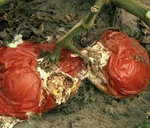 Rhizoctonia solani Kuhn and Sclerotium rolfsii Sacc. are fungal pathogens causing the damping-off on several vegetable crops with high losses of production in both greenhouse and open field cultivation. There is a high incidence of these two pathogens especially in Central and Southern Italy, where tomato (Lycopersicon esculentum L.) plants are widely cultivated.
Rhizoctonia solani Kuhn and Sclerotium rolfsii Sacc. are fungal pathogens causing the damping-off on several vegetable crops with high losses of production in both greenhouse and open field cultivation. There is a high incidence of these two pathogens especially in Central and Southern Italy, where tomato (Lycopersicon esculentum L.) plants are widely cultivated. Currently, few effective fungicides are available to control these pathogens and, when allowed, there are also chemical tools that can have technical, environmental, and toxicological risks. Furthermore, it is difficult to protect the plants by fungicide application when plant foliage is expanded and covers the crown zone where the pathogens start the infection.
Recently, the necessity to reduce the energy costs in farming and to develop more environmental friendly and safer methods have encouraged the scientific research to evaluate the efficacy of new control methods against soil-borne pathogens. Among these new methods, there is the application of antagonistic micro-organisms (yeasts, fungi, bacteria, etc.) alone or combined with fungicides or natural adjuvants.
Several studies have shown the efficacy of these micro-organisms to control pathogens both during cultivation and during post-harvest storage. The main mechanisms of action of these antagonistic micro-organisms consist of mycoparasitization of pathogen, secretion of bioactive molecules, competition for space and nutrients, and stimulation of the plant’s defensive capacity.
In the last years, the research on selection, efficacy, and mode of action of numerous biocontrol agents sprayed on aerial plant part has demonstrated that the bio-formulations have not significantly reduced the crown and root rot disease, because the antagonistic suspension may not reach sufficiently the crown zone covered by dense plant foliage. For this reason, the research is studying to improve the fungicides supply and to maximize their efficacy in field.
A research study made in 2010
The objective of the research conducted by De Curtis et al. (2010) was to evaluate:
- the efficacy of some novel biocontrol bacteria isolates against R. solani and S. rolfsii on tomato plants in growth chamber and in field conditions;
- to evaluate the efficacy of the biocontrol bacteria applied in the field using the drip irrigation system.
The first part of the work was conducted in a growth chamber regulated at 25 °C and 60% RU, with a photoperiod of 15 h light and 9 h dark, using tomato plants grown in plastic pots (8-cm diameter).
The treatments were:
- biocontrol bacteria T1A-2B (Burkholderia cepacia);
- biocontrol bacteria T4B-2A (Pseudomonas spp.);
- biofungicide BSF4 (Agribiotech, Cremona, Italy) based on Bacillus subtilis;
- biofungicide TV1 (Xeda Italia, Forlì, Italy) based on Trichoderma asperellum;
- chemical fungicide tolclofos-methyl (Rhizolex, Basf);
- chemical fungicide azoxystrobin (Ortiva, Syngenta);
- chemical fungicide fosetyl-Al (Alliette, Bayer);
- chemical fungicide fosetyl-Al + propamocarb (Previcur Energy, Bayer).
Disease severity was periodically assessed using a scale of 5 values:
1= no stem lesion;
2= small stem lesion (<25% of the stem circumference);
3= moderate stem lesion (26-50% of the stem circumference);
4= large stem lesion (>51% of the stem circumference);
5= dead plant.
The second part of the work was in field from May to July in the experimental farm at Larino (Campobasso, Italy). The treatments were:
- experimental bacteria T1A-2B
- experimental bacteria T4B-2A
- biofungicide BSF4
- biofungicide TV1
- chemical fungicide tolclofos-methyl
- untreated with water alone
Before transplanting, the plants were wounded on the stem at crown level, after 1 h the plants were treated with bio and synthetic fungicides, after 24 h the plants were inoculated with fungal pathogens. Then the plants were transplanted, each plant was distanced 60 cm on the row and rows were distanced 100-cm each other. Seven days later, treatments were weekly repeated three times and the fungicides were supplied using a drip irrigation system.
The disease incidence and severity were weekly assessed beginning 10 days after inoculation until commercial maturity of the tomatoes. The evaluations were made using the same values scale, as previously described.
The results of growth chamber experiments showed that the isolate T1A-2B of Burkholderia cepacia significantly inhibited the damping-off caused by S. rolfsii, reducing the disease incidence by 81% compared to the untreated control; while B. cepacia did not affect the R. solani infection. The fungicide action of T1A-2B resulted more effective than the other bio fungicides and the chemical fungicides containing fosetyl-Al, whereas its efficacy resulted comparable to that of tolclofos-methyl and azoxystrobin. The isolate T4B-2A of Pseudomonas spp. resulted ineffective against S. rolfsii, while it significantly reduced the incidence of R. solani by 47.4% compared to untreated control.
The results of field experiments showed that the isolate T1A-2B reduced significantly the incidence of R. solani by 56% and 64% and that of S. rolfsii by 58% and 33% in 2006 and 2007, respectively. Disease reductions were significantly also for the isolate T4B-2A, which reduced the incidence of R. solani by 63% and 59% and that of S rolfsii by 59% and 73% in 2006 and 2007, respectively. In both years, chemical fungicide tolclofos-methyl resulted the most effective reducing the incidence of both pathogens by 100%.
Ultimately, the drip irrigation used to supply fungicides resulted a suited and effective technique to reach the stem at crown level, in addition this system has allowed the simultaneous treatments of single plants at different phenological stages. The work has shown the possibility to use biological agents to control the fungal pathogens responsible of the tomato damping-off.
Original study. De Curtis F., Lima G., Vitullo D., De Cicco V., "Biocontrol of Rhizoctonia solani and Sclerotium rolfsii on tomato by delivering antagonistic bacteria through a drip irrigation", Crop Protection, 2010, Issue N. 29, pagg. 663-670.
Further info:
Filippo De Curtis
Email: decurtis@unimol.it
